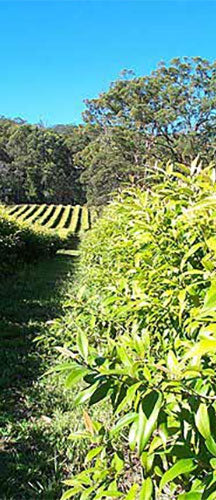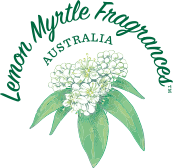The story of Lemon Myrtle (Backhousia citriodora)

The Lemon Myrtle Story
The Australian Aborigines have been using lemon myrtle in cooking, tea and as a remedy for cuts and abrasions for thousands of years.
It is only relatively recently the medical world has shifted attention to find out more about traditional plant derived medicines particularly the effect on microbial diseases. Studies of Australian native plants, such as lemon myrtle have already found some surprising qualities in this area which continue to be the focus of research.
From a European perspective, Lemon Myrtle or Backhousia citriodora was named after James Backhouse, an English botanist who travelled to Australia in the 1830’s and it was in 1853, botanist Ferdinand von Mueller named the genus after his friend.
In 1888 the leaf of the Backhousia citriodora was first investigated by Schimmel and Co of Dresden Pharmaceutical Company where they were able to isolate and identify the high (90-97%) citral content in their analysis of the oil and recognise that for Lemon Myrtle Essential Oil “there is probably a future”.
In 1889 Joseph Maiden, director of the Royal Botanical Gardens in Sydney referenced Backhousia citriodora and the studies of Schimmel and Co in his book “Useful Native Plants of Australia”.
The native plant however has now come into its own for its culinary appeal and medicinal qualities. Previously wild harvested from virgin rainforests in Northern NSW and South East Queensland, the plant was traditionally used topically for wounds and, clearly recognising the benefits for upper respiratory issues, the leaves were soaked in water and heated to allow the inhalation of the vapours. Natural treatments which we are now moving back to, are aided by the commercial availability of the Essential Oil which is extracted at harvest.
From the early 1900’s, the foliage was harvested from wide stands of trees in the hinterland north of Brisbane, Queensland. The distilled oil was then exported to Europe and the United States and the industry grew, even exporting to troops in the Pacific due to a shortage of lemon flavouring and an Australian soft drink company using the oil to flavour lemonade.
Rediscovered around the late 1980’s early 1990’s, the industry has grown significantly with most commercial plantations now stretching within the high rainfall locales around Coffs Harbour in NSW up to a little north of Mackay in Queensland in nutrient rich soils. Preferring a sub-tropical climate, young trees are subject to frost and drought, but once established, Lemon Myrtle trees are relatively resilient.
Scientific research over the years, including by Charles Sturt University, has documented that Lemon Myrtle has excellent antibacterial, antimicrobial and antifungal properties, more-so than the better-known Tea Tree oil. Rich in calcium and high in antioxidants, lutein (a carotenoid compound important for eye health – particularly the macular) Vitamins A, E, zinc and magnesium, Lemon Myrtle is now being viewed as a functional food, but further, its benefits are also being felt in a wide range of skin and personal care products.
Lemon Myrtle’s rediscovery and popularity has in turn encouraged more research which has now advanced the future of the indigenous plant as a significant find and is most popular in the following ways:
- A culinary ingredient – with both the oil and leaf able to be used in sweet and savoury dishes and drinks.
- Aromatherapy application – the refreshing fragrance is calming and the high citral content, Lemon Myrtle Oil acts as an antiseptic, is anti-bacterial, anti-fungal and has anti-microbial properties. It is also naturally high in antioxidants, Vitamins A and E, calcium and zinc and magnesium. Assists with upper respiratory track issues such as sinus, colds, bronchitis, flu and many other ailments.
- An effective cleaning agent – with its anti-bacterial, anti-fungal and antiseptic properties Lemon Myrtle Oil can be used every day to clean hard surfaces and fabrics.
How to grow Lemon Myrtle
The Lemon Myrtle is a beautiful small native tree for the home garden. It grows to around 4-6m (12-20") tall and about 2m (6') wide. While very difficult to germinate or strike, once established, it is very easy to grow and likes a position in part shade through to full sun, and a deep rich soil. It does well in most mainland areas of Australia, but needs protection from frost, especially when young.
The tree can be propagated from cuttings which are best taken in November when the plant has new growth. The cuttings should include some wood from the previous year and be around 10 cm in length. Use a good mix of sandy propagation soil and dip in growth hormone to increase the success rate of your cuttings. Keep the cuttings moist during hot weather and do not let the soil get too dry.
When taking cuttings choose a plant that has the best aroma, each myrtle has different genetics so some will be stronger in fragrance than others. Once your cuttings are established you can either plant in fairly rich soil or in a garden pot.
The leaves are great to have in the garden to make fresh tea, use in cooking or just scrunch between your fingers to enjoy the lemony fragrance.
Germicidal Properties
Researchers at NSW Charles Sturt University found that Lemon Myrtle has excellent antibacterial and antifungal properties. In fact, studies suggest that Backhousia citriodora (Lemon Myrtle) oil has better antibacterial and antifungal properties than the better known tea tree (Melaleuca alternanthera)
Lemon Myrtle oil has strong germicidal powers. In standard tests, Atkinson & Brice were able to demonstrate the antibacterial properties of the Lemon Scented Myrtle (Backhousia citriodora). Tests carried out by researchers on the Germicidal powers indicate that B. citriodora oil had double the rating on Eucalyptus citrodora in controlling Salmonella typhii, the test organism.
Even though the Rideal-Walker test has now been superseded by the Sykes Kesley test, it still remains a valid test. Backhousia has a co-efficient rating of 16 where Eucalyptus citriodora only scores 8. Germicidal properties of Lemon Myrtle have also been proven to be 19.5 times the power of the disinfectant Phenol using the Rideal-Walker test.
